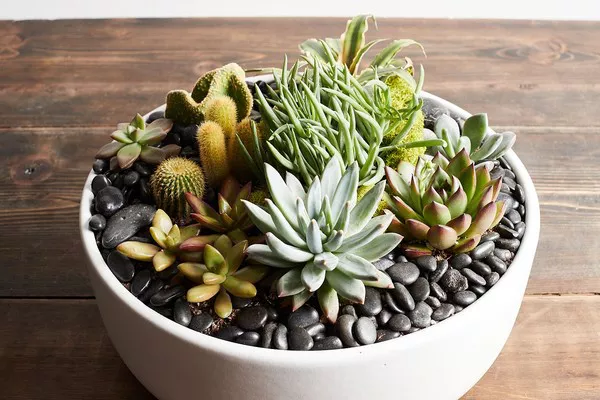Succulents, with their captivating forms and minimalistic beauty, have become a favorite among plant enthusiasts and beginners alike. These hardy plants are renowned for their ability to thrive in various conditions, making them ideal choices for indoor spaces. However, ensuring the longevity and vitality of indoor succulents requires a careful balance of factors. In this comprehensive guide, we will delve into the intricacies of keeping indoor succulents alive and help you cultivate a thriving succulent haven.
Understanding Indoor Succulents
1. The Succulent Advantage
Succulents have adapted to survive in arid environments by storing water in their leaves, stems, or roots. This unique feature allows them to endure periods of drought and limited watering, making them well-suited for indoor cultivation.
2. Selecting the Right Indoor Succulents
Before bringing succulents indoors, choose species that are better suited for indoor conditions. Opt for varieties that don’t grow too large or quickly, as space restrictions can impact their health and aesthetics. Some recommended choices include Echeverias, Haworthias, and Aloe Vera.
Creating the Ideal Indoor Environment
1. Sunlight and Placement
Lighting Requirements: Succulents require ample sunlight to thrive. Place them near a south- or west-facing window where they can receive at least 6 hours of indirect sunlight each day. If natural light is limited, consider using grow lights designed for succulents.
Rotation: To ensure even growth, rotate your succulents every few weeks, allowing all sides to receive sufficient light.
2. Temperature and Humidity
Temperature Range: Most succulents prefer temperatures between 60-75°F (15-24°C). Avoid exposing them to extreme temperature fluctuations.
Humidity Considerations: Succulents thrive in low humidity environments, which makes indoor conditions suitable. However, if you live in a very dry climate, consider using a humidity tray or occasional misting to maintain a balanced environment.
Watering Wisely
1. Understanding Watering Needs
Less is More: Succulents dislike sitting in wet soil. Watering sparingly is key to preventing root rot. Allow the top inch of the soil to dry out before watering again.
Watering Frequency: Typically, indoor succulents require watering every 2-4 weeks, but this can vary based on factors like temperature and humidity. Adjust your watering schedule accordingly.
2. Watering Techniques
Soak and Dry Method: When watering, thoroughly soak the soil until water drains out of the pot’s bottom. Empty the saucer to avoid water accumulation. Allow the soil to dry out completely before the next watering.
Avoid Overhead Watering: Water the soil directly rather than the plant itself to prevent water from getting trapped in the leaves, which can lead to rot.
3. Seasonal Adjustments
Winter Dormancy: During the winter months, when succulents enter a period of dormancy, their watering needs decrease. Water less frequently and be cautious not to overwater.
Choosing the Right Potting Mix and Containers
1. Well-Draining Mixes
Importance of Drainage: Plant succulents in well-draining potting mixes specifically designed for cacti and succulents. Adequate drainage prevents waterlogged roots.
DIY Mix Recipe: Create your own mix by combining potting soil, coarse sand, and perlite in a 2:1:1 ratio, respectively.
2. Appropriate Containers
Size Matters: Choose containers that provide ample space for your succulents to grow. Ensure the pots have drainage holes to prevent excess moisture buildup.
Repotting: As succulents grow, they may outgrow their containers. Repot them into slightly larger pots with fresh potting mix every 1-2 years.
Nutrition and Fertilization
1. Balanced Fertilizer: Use a diluted, balanced liquid fertilizer formulated for succulents. Apply during the active growing season (spring and summer) every 4-6 weeks.
2. Moderation is Key: Over-fertilizing can lead to excessive growth or weak plants. Follow the package instructions and avoid applying fertilizer to dry soil.
Preventing and Treating Common Issues
1. Pests and Diseases
Vigilance: Keep an eye out for pests like aphids, mealybugs, and spider mites. Early detection allows for swift intervention.
Natural Remedies: Use neem oil or insecticidal soap to treat pests. Quarantine new plants before introducing them to your succulent collection.
2. Dealing with Overwatering
Recognizing Signs: Yellowing or dropping leaves, mushy stems, and an unpleasant odor indicate overwatering and potential root rot.
Emergency Treatment: If you suspect overwatering, remove the plant from the soil, trim affected roots, and let it air-dry for a day before replanting in dry soil.
Conclusion
The world of indoor succulents is one of artful balance, requiring a delicate blend of light, water, and care. By understanding their unique needs, providing appropriate conditions, and nurturing them with patience, you can enjoy the beauty and resilience of these captivating plants. Remember, each succulent is a living masterpiece that responds to your attentiveness, creating a harmonious synergy between plant and caretaker. With the insights shared in this guide, you’re equipped to embark on a rewarding journey of cultivating and keeping indoor succulents alive, enhancing your living spaces with their natural charm and elegance.


